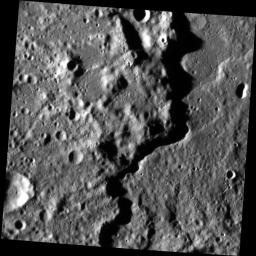
|
Rembrandt’s Rim
- Click the image above for a larger view
- Full-Res JPEG (1096 x 1096) (150.0 kB)
- Full-Res TIFF (1096 x 1096) (1.2 MB)
Caption:
The Rembrandt basin, first discovered during MESSENGER's second flyby of Mercury, is the youngest of the large impact basins that formed on Mercury. Here you can see a portion of the rim. The rim scarp runs north-south along the scene, casting a meandering shadow that separates the basin exterior on the left from the interior on the right. The two sides don't look hugely different, likely because during and after the basin-forming event molten rock coated much of this area, later solidifying to form the surface we see today.
This image was acquired as a targeted set of stereo images. Targeted stereo observations are acquired at resolutions much higher than that of the 200-meter/pixel stereo base map. These targets acquired with the NAC enable the detailed topography of Mercury's surface to be determined for a local area of interest.
Date acquired:
August 14, 2013
Image Mission Elapsed Time (MET):
18791579
Image ID:
4630071
Instrument:
Narrow Angle Camera (NAC) of the Mercury Dual Imaging System (MDIS)
Center Latitude:
-33.54°
Center Longitude:
77.82° E
Resolution:
104 meters/pixel
Scale:
This scene is approximately 106 km (66 mi.) across
Incidence Angle:
79.3°
Emission Angle:
2.8°
Phase Angle:
76.7°
Background Info:
The MESSENGER spacecraft is the first ever to orbit the planet Mercury, and the spacecraft's seven scientific instruments and radio science investigation are unraveling the history and evolution of the Solar System's innermost planet. MESSENGER acquired over 150,000 images and extensive other data sets. MESSENGER is capable of continuing orbital operations until early 2015.
For information regarding the use of images, see the MESSENGER image use policy .
Cataloging Keywords:
| Name | Value | Additional Values |
|---|---|---|
| Target | Mercury | |
| System | ||
| Target Type | Planet | |
| Mission | MESSENGER | |
| Instrument Host | MESSENGER | |
| Host Type | Orbiter | |
| Instrument | Mercury Dual Imaging System (MDIS) | |
| Detector | Narrow Angle Camera (NAC) | |
| Extra Keywords | Grayscale, Impact, Map, Radio, Shadow | |
| Acquisition Date | ||
| Release Date | 2013-09-18 | |
| Date in Caption | 2013-08-14 | |
| Image Credit | NASA/Johns Hopkins University Applied Physics Laboratory/Carnegie Institution of Washington | |
| Source | photojournal.jpl.nasa.gov/catalog/PIA17499 | |
| Identifier | PIA17499 | |
